Global Market Comments
June 5, 2020
Fiat Lux
Featured Trade:
(JUNE 3 BIWEEKLY STRATEGY WEBINAR Q&A),
(FB), (M), (UAL), (LVS) , (WYNN), (MS), (SPX), (TBT), (TLT), (AAPL), (FB), (MSFT), (SDS), (SPX), (AMZN) (LEN), (KBI), (PHM), (TSLA)
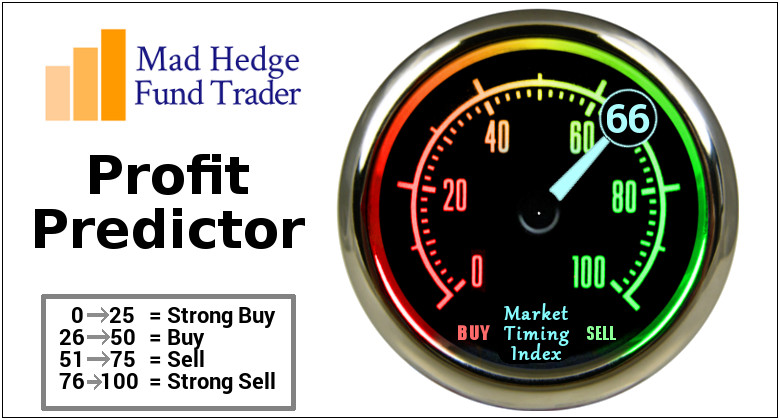
Global Market Comments
June 5, 2020
Fiat Lux
Featured Trade:
(JUNE 3 BIWEEKLY STRATEGY WEBINAR Q&A),
(FB), (M), (UAL), (LVS) , (WYNN), (MS), (SPX), (TBT), (TLT), (AAPL), (FB), (MSFT), (SDS), (SPX), (AMZN) (LEN), (KBI), (PHM), (TSLA)

Below please find subscribers’ Q&A for the June 3 Mad Hedge Fund Trader Global Strategy Webinar broadcast from Silicon Valley, CA with my guest and co-host Bill Davis of the Mad Day Trader. Keep those questions coming!
Q: Domino's Pizza (DPZ) is at all-time highs? Would you buy this name right here, right now?
A: No, I would not even buy their pizza. You would be crazy to buy them right now up here this high. I prefer Round Table, the pizza not the stock. All of these “reopening” stocks are way overextended.
Q: Will the riots delay the recovery?
A: Yes, they will, it could take as much as another 1% off the current GDP growth rate. It’s hitting the already worst-hit sector—retailers. Many retailers will not come back from these, especially the small ones. These businesses were just returning from being closed for two months when they got burned down. But we won’t see it in the macro data for many months because its happening largely at the micro level. If you didn’t like Macy’s (M) before when it was headed for Chapter 11, you definitely won’t like it now that it is burning down.
Q: If airlines like United Airlines (UAL) can’t use the middle seat, do you see ticket prices going up 10%, 25%, or 50%?
A: Yes. In theory, to just cover the middle seat, they have to increase prices 33%. And there will be a whole lot of new costs that the airlines have to endure as part of this pandemic, such as extra cleaning, disinfecting, and temperature taking. So, they’re really going to need to increase prices by 50% or more just to break even. My guess is that the airline industry will shrink in half in the fall when all the government bailout money runs out. So, I've been telling people to take profits on the airlines, especially if you have a double or triple in them, or if you have the LEAPS.
Q: Is Facebook (FB) immune from any big selloff?
A: No, nobody is immune—look how much Facebook sold off in March, some 35%. Mark Zuckerberg seems to be making a deal with the devil, accommodating the president with unrestricted incendiary Facebook posts. And the consequences of a Democratic win for Facebook could be hugely negative, so I am not participating in that one. Mark doesn’t have a lot of friends in congress right now so regulation looms.
Q: What do you think about buying Las Vegas Sands (LVS) or Wynn Resorts (WYNN) on the expectation of reopening?
A: I’m a Nevada resident and get frequently updated on the casino news. They’re only going to be allowed half of peak casino visitors that they had in January, so they will generate huge losses. Almost all companies are being allowed to reopen back to half the level that guarantees bankruptcy in 3-6 months. But we won’t see that in the numbers for many months either. I’m negative on any industry that depends on packing people in, like airlines, cruise lines, and movie theaters.
Q: What are the chances of a mass student debt cancellation?
A: That is a possibility if the Democrats win in November, and it has already been proposed. It is about a $1.5 trillion ticket. If you’re bailing out large companies, small companies, airlines, and the oil industry, why not students? It would have the benefit of adding 10 million more consumers to the economy, who are not current participants because they have massive student debts that are appreciating at 10% a year and have terrible credit ratings. So that would be another great economic stimulus measure. By the way, I paid off my student loans 40 years ago in a lump sum payment with my first paycheck from Morgan Stanley (MS). How much did four years of college cost during the 1960s? $3,000. Such a deal.
Q: What’s the next resistance level on the S&P 500 (SPX)?
A: The target we’ve been looking for is $3,125. I’m looking for roughly $40 points above that level—it should be about $3,165. We’re in uncharted territory here because nobody’s ever seen a market rise 40% in two months, so any technical recommendation has to be bearish except for a very short term, like intra-day or daily views.
Q: Any correlation between the 1918 epidemic and now?
A: Here is your History of Virology Lesson 101 for today. There is some similarity, but the 1918 flu actually originated on a farm in Kansas, had a 2% death rate, took a trip to Europe, mutated, came back months later, and then had a death rate of 50%. We haven't seen that second wave yet, or major mutations. We have seen a couple of different DNA strands out there though, meaning we would need multiple different vaccines when we get them. By the way, it was called the “Spanish Flu” because during WWI, every country had censorship except Spain because it was not a combatant. So, the pandemic was only reported in the Spanish newspapers.
Q: Would you get out of any of the previously recommended LEAPS?
A: Yes, I would be taking profits on all of your LEAPS—whether tech, domestic, “recovery”, or whatever else—so if we do get a correction over the summer, you can get back in at better prices, with longer expirations. You can go two years out from say August for example. The risk/reward today is terrible.
Q: Would you hold on to the (SDS) right now, or wait for the pullback
A: No, we have offsetting profits on all of our (SDS) positions, until today—if the market keeps accelerating to the upside, SDS losses will start to offset our profits on the positions, so that’s why I would get out.
Q: Should I buy the ProShares Ultra-Short 20 + Year Treasury Bond Fund (TBT)? I don’t do options.
A: You don’t need to do options, (TBT) is an ETF; anybody can buy that, it’s just like buying a stock.
Q: What is happening with the Australian market?
A: It will trade with the US stock market tick for tick, which means they’ve had a fantastic rally, overdue for a selloff. Wait to buy the next dip.
Q: If markets are going to go down soon, why exit the (SDS)
A: It may go up first before it goes down. And in any case, I have a great profit on the combined position of long (SDS) and short bonds. These days, I like taking big profits rather than praying they become bigger. It’s about risk control and knowing what you can get away with in certain market conditions.
Q: Is now the time to sell the highflyers in tech?
A: Yes, I would be selling Apple (AAPL), Facebook (FB), Microsoft (MSFT), and Amazon (AMZN). Get dry powder, which is worth a lot after you’ve seen a move like this; especially if the economy gets worse, which is likely. My late mentor Barton Biggs taught me to always leave the last 10% of a move for the next guy.
Q: At what point do you buy the ProShares Ultra Short S&P 500 ETF (SDS) outright?
A: Only if there is an immediate collapse in the market, which I can’t foresee with any certainty. When you play these bear ETFs, the costs are very high. You are short double the (SPX) dividend, which is about 5% a year, plus hefty management fees. So, you really have to catch a quick, large move to the downside to make any real money.
Q: Real estate seems like the big winner of the pandemic. Will prices be up by the end of the year or is this just a temporary spike?
A: They will be up at the end of the year. I have been telling readers all year that their home will be their best investment in 2020 and that is coming true. Real estate has a massive tailwind behind it which has really been in place for a couple of years now, and that is the millennials upgrading and buying houses. The pandemic has really poured gasoline on the fire and triggered a stampede out of the city and into the suburbs. Having 85 millennials ready to upgrade their homes is a huge positive for the real estate market, and I’d be looking to buy the homebuilders on any dip. That’s probably the best domestic play out there. Buy Lennar Corp. (LEN) and Pulte Homes (PHM) on dips.
Q: Post pandemic, will manufacturing have any way of helping US economic growth, or is bringing back the supply chains fake news?
A: It is fake news because if companies bring back production, it will be machines and not people making things. Unless you want to pay $10,000 for an iPhone, or $5,000 for a low-end laptop. Oh yes, and the stocks which made these things would be 90% lower as well. That’s what those products cost in today’s dollars if they were made in the United States. I wouldn't count on any repatriation of US jobs unless people want to work for $3 a day like the Chinese do. Offshoring happened for a reason.
Q: How do I hedge a municipal bond portfolio?
A: You might think about taking profits in muni bonds. They’re yielding around 2% and change. And they could get hit with a nice little 20-point decline if the US Treasury bond market (TLT) falls apart, which it will. Then you can think about buying them back. If you really want to hedge, you sell short the (TLT) against your long muni bond portfolio. But that is an imperfect hedge because the default rate on munis is going to be much higher than it is now than it was in 2008-2009, and much higher than US Treasuries, which never defaults despite what the president has said.
Q: What is dry powder?
A: It means having cash to buy stocks at market bottom. In the 1800s before cartridges were invented, black powder got wet whenever it rained causing guns to fail to shoot. That is the historical analogy.
Q: What do we do now if we’re getting started?
A: It will require a lot of discipline on your part as coming in at market tops is always risky. Wait for the next trade alert. Every one of these is meant to work on a standalone basis. I would do nothing unless you see one of these things happen; any 2 or 3-point rally in bonds (TLT), you want to sell short. We’re just at the beginning of a multiyear trade here so it’s not too late to get back into that. Gold (GLD) is probably safe to buy on the dip here since we are at the very beginning of a historic expansion of the global money supply. I wouldn’t touch any stocks unless we get at least a 10% drop and then I'll start putting out call spread recommendations on single stocks. But right here, on top of the biggest bounceback in stocks in market history, don’t do anything. Just read the research and make lists of things to buy when they do dip—something I do for you anyway.
Q: What about Beyond Meat (BYND)?
A: The burgers are not that bad, but the stock is way overpriced and you don’t want to touch it. It's one of the fad stocks of the day.
Q: Can we access the slides after the webinar?
A: Yes, we post it on the website under your “Account” section about two hours after we’re done.
Q: Are you saying sell everything currently profitable?
A: Yes, I would be selling everything on a short term basis, keep tech and biotech on a long term basis. We are the most overbought in history and you don’t get asked twice to sell tops. But yes, it could go higher before the turn happens. From a risk-reward point of view, it’s terrible to do anything right now.
Q: Could we get a pullback to the $260-$270 area in the S&P 500 (SPY)?
A: Yes, especially if we get a second worse wave of corona and the stimulus takes much longer than we thought to get into the economy, or if the rioting continues.
Q: Should you sell CCI now?
A: Yes, I actually would. You have a 57% gain in the stock in ten weeks, so why not? Long term, it’s a hold.
Q: Are any retail stocks a buy?
A: No, they aren’t because a lot of them are going to go under but you don’t know which ones. After shutting down and losing 60% of their revenues, they’re now being burned down. The pros who do well in the sector are bankruptcy specialists who have massive research teams that analyze every lease in every mall and then cherry-pick. You and I don’t have the ability to do that so stay away.
Q: What is the best way to play real estate?
A: Buy a house. If not, then you buy (LEN), (KBI), and (PHM).
Q: Is it too late to get back in the stock market?
A: Yes, I'm afraid it is. Buying, because it has gone up, is a classic retail investor mistake. After this meltdown, maybe you will learn to buy stocks when everyone else is throwing up on their shoes. That's what I was doing in March and we got returns of 50% to 100% on everything and 500% to 1,000% on the LEAPS (TSLA).
Q: Are you buying puts?
A: No, I am not taking outright short positions any more than I have now because we have a Fed-driven melt-up underway with a stimulus that's 20x larger than that seen during the 2008-2009 Great Recession. When I don’t know what’s going to happen, I get out.
Good Luck and Stay Healthy.
John Thomas
CEO & Publisher
The Diary of a Mad Hedge Fund Trader
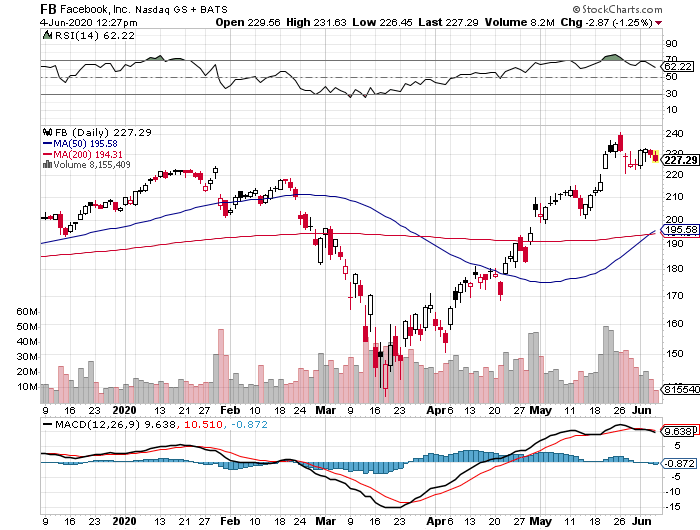
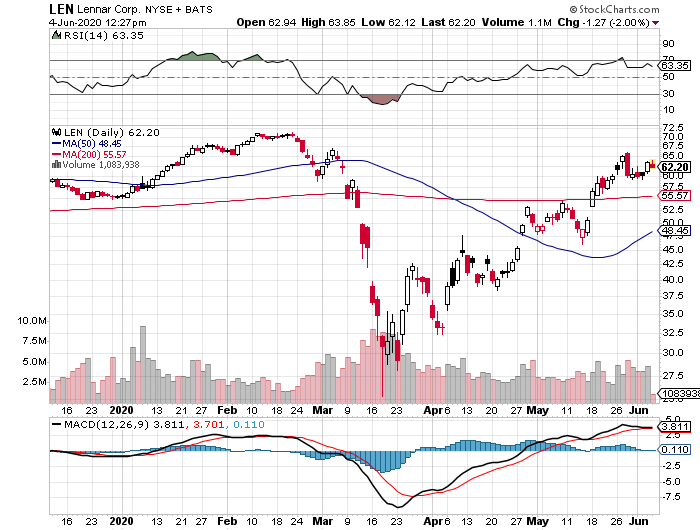
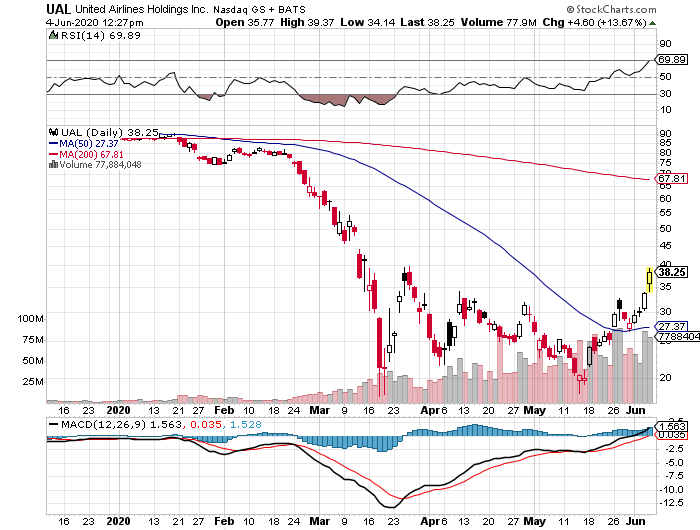
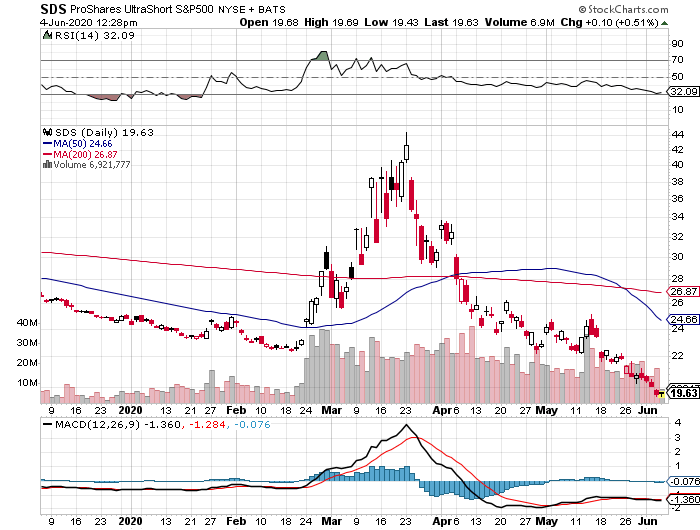

Global Market Comments
May 11, 2020
Fiat Lux
Featured Trade:
(MARKET OUTLOOK FOR THE WEEK AHEAD, or THE NEXT GOLDEN AGE HAS ALREADY STARTED)
(TLT), (TBT), (SPY), (INDU), (VIX),
(DAL), (BRK/A), (LUV), (AA), (UAL)
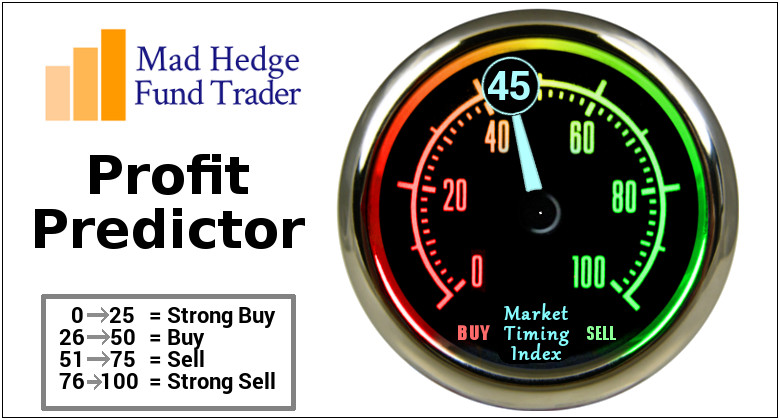
I always get my best ideas when hiking up a steep mountain carrying a heavy backpack.
Yesterday, I was just passing through the 9,000-foot level on the Tahoe Rim Trail when suddenly, the fog lifted and the skies cleared. I was hit with an epiphany.
It was my “AHA” moment.
The next American Golden Age, the next Roaring Twenties, started on March 23.
However, you have to dive deep into investor psychology to reach that astonishing conclusion.
The conundrum of the day is why stocks are trading at a plus 30X multiple two months into a Great Depression. The economic data has been so horrific that the mainstream news has been reporting them.
Some 30 million unemployed on the way to 51 million? Those are Fed numbers, not mine (click here for the link ). Over 52% of small businesses going bankrupt in the next six months? A GDP that is shrinking at an amazing -40% annualized rate?
Yet, we have a Dow Average that has risen a breathtaking 38% in six weeks. The market has essentially dropped 38% and risen 38% over three months, with the Volatility Index (VIX) making a brief visit to the $80 handle.
To understand these massive contradictions, you have to understand what investors think they are buying. They are not hoovering up stocks that are cheap, offer value, or at the bottom of an economic cycle.
Instead, they are investing in a hope, a vision, an expectation that the coming decade will bring a major economic boom. Yes, they are buying my coming American Golden Age.
Only 10% of the value of a stock is reflected in current year earnings, according to Dr. Jeremy Siegal at the Wharton School of Economics (click here to go to the site). The other 90% is in the following nine years. Investors have written off this year’s earnings and are paying up for the following nine.
Long term followers of this newsletter are well aware of my approaching forecast of the next Roaring Twenties (click here for the link).
Except that this time we have a catapult, the pump-priming effects of the pandemic. The government has stepped in with $14 trillion worth of fiscal and monetary stimulus. Creative destruction is taking place at an exponential rate. Companies have to become hyper-efficient overnight or die.
It’s not rocket science. More than 85 million millennials are aging into their peak spending years, buying homes, cars, and all the luxuries of life. Every time this has happened for the past century, US economic growth leaped to 4%.
It happened in the 1920s, the 1960s, the 1990s, and is about to take place in the 2020s. And with each pop in growth, the stock market rises about 400%. Look at your long-term charts and you’ll see I’m dead right.
That takes us from the March 23 Dow Average low at 18,000 up to 72,000 by 2030, except that it’s a low number. Throw in the hyper-acceleration of innovation by the technology and biotech sectors, a Dow 120,000 is within reach.
You may recall that number from my marketing pitches, except that this time it’s happening. In a decade you are going to look like an absolute genius by following the recommendation of the Mad Hedge Fund Trader.
It also means that we may not see market corrections of any more than 10% this year. That would take us down to a Dow Average of 22,500, and an (SPX) of 2,600 in the coming months. That’s where you should jump in and buy with both hands. The only way I would be wrong is if the US epidemic explodes to unimaginable levels, which is not impossible.
Last week, U-6 unemployment rates exploding to a stratospheric 22.8%. The rate was far higher among high school graduates, but only 8% for college grads. Some 20.2 million lost jobs, ten times the previous record, and more than seen during the Great Depression. The BLS (click here) said the true figure was probably 5% higher due to counting anomalies and a huge backlog of data. And this is just the beginning. The good news is that next month, only 10 million jobs will be lost.
NASDAQ (QQQ) turned positive for 2020, and the followers who piled into tech LEAPS at the March bottom are eternally grateful. Tech and biotech are the only places to be. Everywhere else is a waste of time and money. The entire country is turning into a tech economy or going out of business. Buy tech on dips.
Warren Buffet sold all his airline shares, taking a major loss, including Delta (DAL), Southwest (LUV), American (AA) and United (UAL). The Fed’s $50 billion airline bailout blocked him from making a real killing. His Berkshire Hathaway (BRK/A) (click here) owned close to 10% of all of them. The complete collapse of tourism and business travel are the issues. He sees no recovery in the foreseeable future. They don’t call him the “Oracle of Omaha” for nothing.
US Auto Sales are down a mind-blowing -48% in April, the worst on record. Only 8.6 million cars were sold in the US against last year’s annual rate of 17 million. Toyota and Honda saw the biggest falls as their ships can’t unload due to lack of storage space.
The US Treasury will borrow $3 Trillion this Quarter to fund the massive bailout programs. Announced programs amount to 20 times the $789 billion 2009 rescue package, which Republicans opposed. I’m increasing my bond shorts. Sell short (TLT) again, even if we don’t get a decent rally. Oh, and Trump is threatening a default too. He doesn’t see the connection.
Bonds crashed on massive issuance, with the Treasury announcing a record 20-year bond floatation. Yields hit a one-month high. With the (TLT) down $18 from its recent high, I am taking profits on my bond shorts. I’ll be selling the next rally….again. This could be my core trade for the next decade.
Consumer Debt soared to $14.3 trillion in Q1, a new all-time high. A lot of people are living on their credit cards right now.
Trump threatens to cancel China trade deal, blaming them for Covid-19, sending stocks into a 400-point dive. The last time he did this, shares plunged 20%. It’s all part of an effort to divert attention from the administration’s disastrous handling of the pandemic. America’s Corona deaths are now 20 times China’s, and they are still an emerging nation. Just what we needed, a renewed trade war on top of a pandemic-caused Great Depression, as if the market needed more uncertainty. Sell rallies in the (SPY)
When we come out on the other side of this, we will be perfectly poised to launch into my new American Golden Age, or the next Roaring Twenties. With interest rates at zero, oil at $0 a barrel, and many stocks down by three quarters, there will be no reason not to. The Dow Average will rise by 400% or more in the coming decade.
My Global Trading Dispatch performance had one of the best weeks in years again, up a gob-smacking +6.46%. We are now only 0.65% short of a new all-time high.
My aggressive short bond positions came in big time on the back of theannounced $3 trillion in new debt issuance in Q2. Short bonds are far and away the better quality trade of buying stocks at these elevated levels.
May is up +6.46%, taking my 2020 YTD return up to 2.59%. That compares to a loss for the Dow Average of -13.43% from the February top. My trailing one-year return exploded to 43.77%. My ten-year average annualized profit returned to +34.14%.
This week, Q1 earnings reports continue, and so far, they are coming in much worse than the most dire forecasts. We also get the monthly payroll data, which should be heart-stopping to say the list.
The only numbers that count for the market are the number of US Coronavirus cases and deaths, which you can find here.
On Monday, May 11 at 10:00 AM, the April US Inflation Expectations are out. Caesar’s Entertainment (CZR) and Marriot International (MAR) report earnings.
On Tuesday, May 12 at 5:00 PM, the NFIB Small Business Optimism Index for April is released. Toyota Motors (TM) reports earnings.
On Wednesday, May 13 at 9:30 AM, the ever fascinating weekly Cushing Crude Oil Stocks is announced. Cisco Systems (CSCO) reports earnings.
On Thursday, May 14 at 8:30 AM, we get another blockbuster Weekly Jobless Claims. Advanced Micro Devices (AMD) reports earnings.
On Friday, May 15 at 7:30, AM the Empire State Manufacturing Index is published. The Baker Hughes Rig Count follows at 2:00 PM.
As for me, I’ll continue my solo circumlocution of the 160 mile Tahoe Rim Trail every afternoon in ten-mile segments. Why solo? Do you know anyone else who wants to hike 160 miles at 10,000 feet in two weeks?
Stay healthy.
John Thomas
CEO & Publisher
The Diary of a Mad Hedge Fund Trader
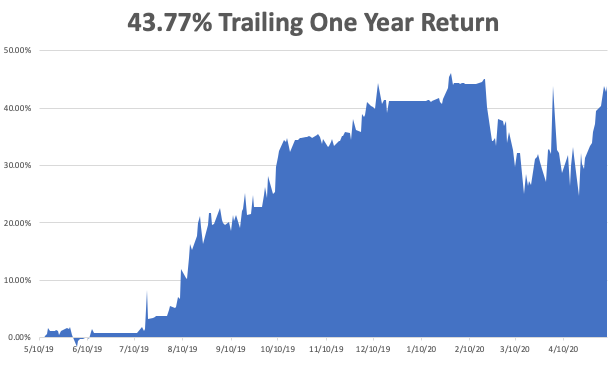
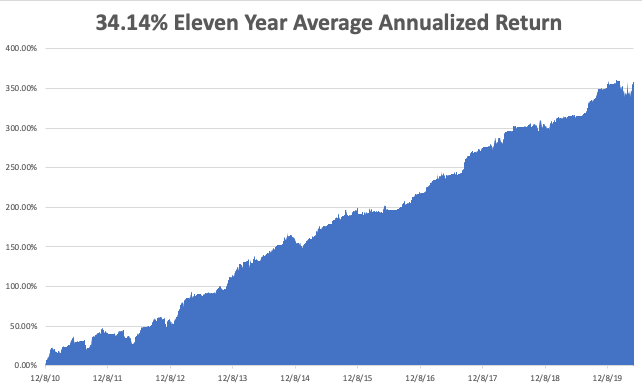
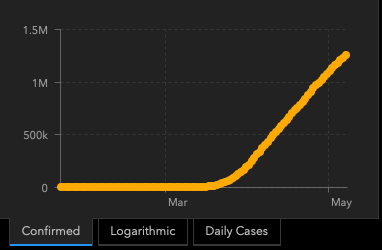
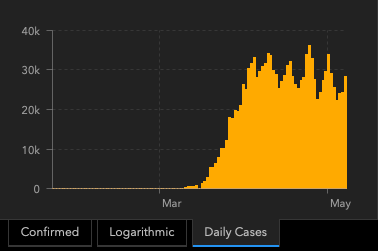
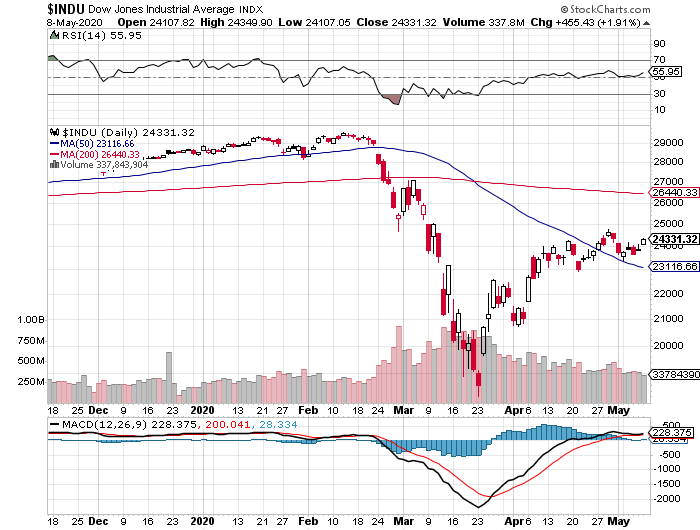
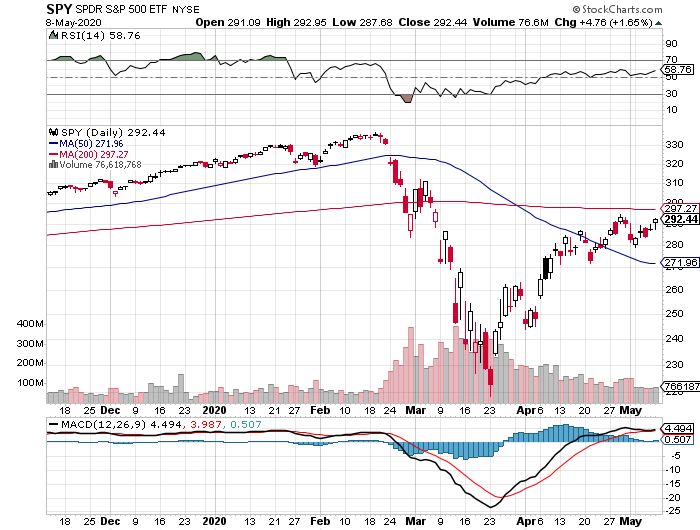
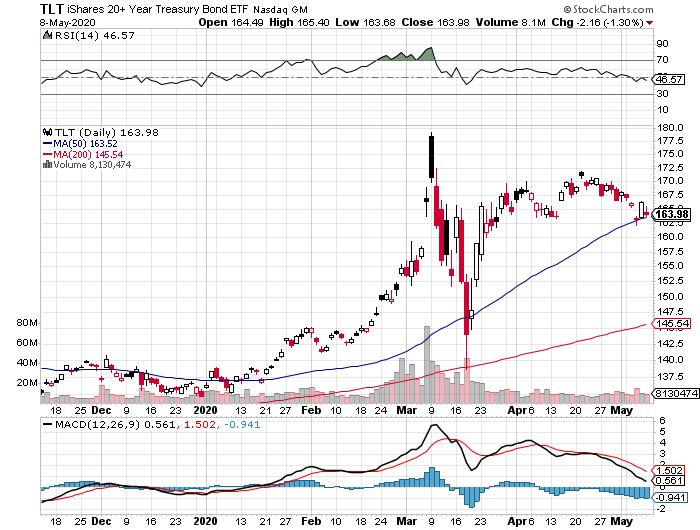
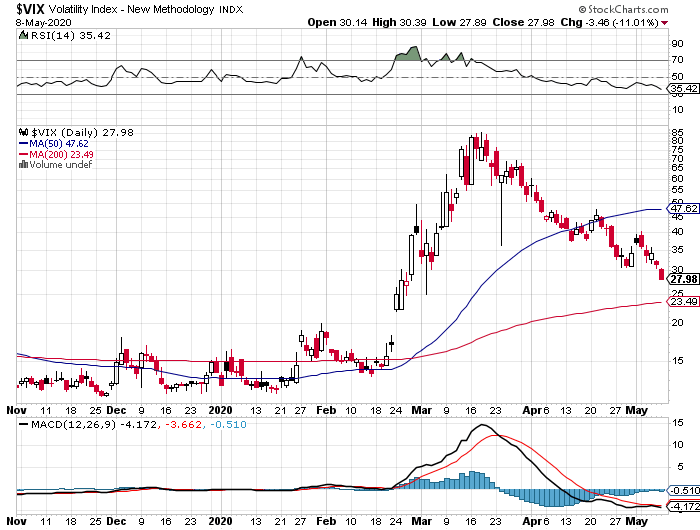

Global Market Comments
May 8, 2020
Fiat Lux
Featured Trade:
(MAY 6 BIWEEKLY STRATEGY WEBINAR Q&A),
(UNG), (UAL), (DAL), (INDU), (SPY), (SDS),
(P), (BA), (TWTR), (GLD), (TLT), (TBT)
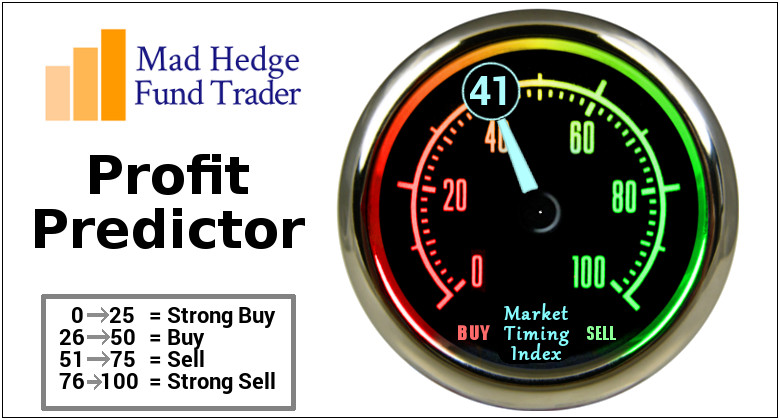
Below please find subscribers’ Q&A for the Mad Hedge Fund Trader May 6 Global Strategy Webinar broadcast from Silicon Valley, CA with my guest and co-host Bill Davis of the Mad Day Trader. Keep those questions coming!
Q: What broker do you use? The last four bond trades I couldn’t get done.
A: That is purely a function of selling into a falling market. The bond market started to collapse 2 weeks ago. We got into the very beginning of that. We put out seven trade alerts to sell bonds, we’re out of five of them now. And whenever you hit the market with a sell, everyone just automatically drops their bids among the market makers. It’s hard to get an accurate, executable price when a market is falling that fast. The important point is that you were given the right asset class with a ticker symbol and the right direction and that is golden. People who have been with my service for a long time learn how to work around these trade alerts.
Q: Is there any specific catalyst apart from the second wave that will trigger the expected selloff?
A: First of all, if corona deaths go from 2 to 3, 4, 5 thousand a day, that could take us back down to the lows. Also, the market is currently expecting a V-shaped recovery in the economy which is not going to happen. The best we can get is a U-shape and the worst is an L-shape, which is no recovery at all. What if everything opens up and no customers show? This is almost certain to happen in the beginning.
Q: How long will the depression last?
A: Initially, I thought we could get out of this in 3-6 months. As more data comes in and the damage to the economy becomes known, I would say more like 6-9, or even 9-12 months.
Q: In natural gas, the (UNG) chart looks like a bullish breakout. Does it seem like a good trade?
A: No, the energy disaster is far from over. We still have a massive supply/demand gap. And with (UNG), you want to be especially careful because there is an enormous contango—up to 50 or 100% a year—between the spot price and the one-year contract price, which (UNG) owns. Once I saw the spot price of natural gas rise by 40% and the (UNG) fell by 40%. So, you could have a chart on the (UNG) which looks bullish, but the actual spot prices in front month could be bearish. That's almost certainly what’s going to happen. In fact, a lot of people are predicting negative prices again on the June oil contract futures expiration, which comes in a couple of weeks.
Q: What about LEAPS on United (UAL) and Delta (DAL)?
A: I am withdrawing all of my recommendations for LEAPS on the airlines. When Warren Buffet sells a sector for an enormous loss, I'm not inclined to argue with him. It’s really hard to visualize the airlines coming out of this without a complete government takeover and wipeout of all existing equity investors. Airlines have only enough cash to survive, at best, 6-8 months of zero sales, and when they do start up, they will have more virus-related costs, so I would just rather invest in tech stocks. If you’re in, I would get out even if it means taking a loss. They don’t call him the Oracle of Omaha for nothing.
Q: Any reason not to do bullish LEAPS on a selloff?
A: None at all, that is the best thing you can do. And I’m not doing LEAPS right now, I’m putting out lists of LEAPS to buy on a selloff, but I wouldn't be buying any right now. You’d be much better off waiting. Firstly, you get a longer expiration, and secondly, you get a much better price if you could buy a LEAP on a 2,000 or 3,000 point selloff in the Dow Average (INDU).
Q: Would you add the 2X ProShares Ultra Short S&P 500 (SDS) position here if you did not get on the original alert?
A: I would, I would just do a single 10% weighting. But don’t expect too much out of it, maybe you'll get a couple of points. And it’s also a good hedge for any longs you have.
Q: What happens if the second wave in the epidemic is smaller?
A: Second waves are always bigger because they’re starting off with a much larger base. There isn't a scientist out there expecting a smaller second wave than the first one. So, I wouldn't be making any investment bets on that.
Q: Pfizer (P) and others seem close to having a vaccine, moving on to human trials. Does that play into your view?
A: No, because no one has a vaccine that works yet. They may be getting tons of P.R. from the administration about potential vaccines, but the actual fact is that these are much more difficult to develop than most people understand. They have been trying to find an AIDS vaccine for 40 years and a cancer vaccine for 100 years. And it takes a year of testing just to see if they work at all. A bad vaccine could kill off a sizeable chunk of the US population. We’ve been taking flu shots for 30 years and they haven’t eliminated the flu because it keeps evolving, and it looks like coronavirus may be one of those. You may get better antivirals for treatment once you get the disease, but a vaccine is a good time off, if ever.
Q: Is this a good time to buy Boeing (BA)?
A: No, it’s too risky. The administration keeps pushing off the approval date for the 737 MAX because the planes are made in a blue state, Washington. The main customers of (BA), the airlines, are all going broke. I would imagine that their 1,000-plane order book has shrunk considerably. Go buy more tech instead, or a hotel or a home builder if you really want to roll the dice.
Q: How can the market actually drop to the lows, taking massive support from the Fed and further injections into account?
A: I don’t think we will get to new lows, I think we may test the lows. And my argument has been that we give half of the recent gains, which would take us down to 21,000 in the Dow and 2400 in the (SPX). But I've been waiting for a month for that to happen and it's not happening, which is why I've also developed my sideways scenario. That said, a lot of single stocks will go to new all-time lows, such as in retailers (RTF) and airlines (JETS).
Q: Would you stay in a Twitter (TWTR) LEAP?
A: If you have a profit, I would take it.
Q: What about Walt Disney (DIS)?
A: There are so many things wrong with Disney right now. Even though it's a great company for the long term, I'm waiting for more of a selloff, at least another $10. It’s actually rallying today on the earnings report. Around the low $90s I would really love to get into LEAPS on this. I think more bad news has to hit the stock for it to get lower.
Q: Are you continuing to play the (TLT)?
A: Absolutely yes, however, we’re at a level now where I want to take a break, let the market digest its recent fall, see if we can get any kind of a rally to sell into. I’ll sell into the next five-point rally.
Q: Any reason not to do calls outright versus spreads on LEAPS?
A: With LEAPS, because you are long and short, you could take a much larger position and therefore get a much bigger profit on a rise in the stock. Outright calls right now are some of the most expensive they’ve ever been. So, you really need to get something like a $10 or $15 rise in the stock just to break even on the premium that you’re paying. Calls are only good if you expect a very immediate short term move up in the stop in a matter of days. LEAPS you can run for two years.
Q: Is gold (GLD) still a buy?
A: Yes, the fundamental argument for gold is stronger than ever. However, it has been tracking one for one with the stock market lately. That's why I'm staying out of gold—I’d rather wait for a selloff in stocks to take gold down; then I’ll be in there as a buyer.
Q: Should I take profits on what I bought in April and reestablish on a correction?
A: Absolutely. If you have monster profits on a lot of these tech LEAPS you bought in the March/early April lows, then yes, I would take them. I think you will get another shot to buy these cheaper, and by coming out now and coming in later, you get to extend your maturity, which is always good in the LEAPS world.
Q: Would you buy casinos, or is it the same risk as the airlines?
A: I would buy casinos and hotels—they have a greater probability of survival than the airlines and a lot less debt, although they’re going to be losing money for years. I don’t know exactly how the casinos plan on getting out of this.
Q: Should we exit ProShares ultra short 20+ year Treasury Bond Fund (TBT) now?
A: No, that’s more of a longer-term trade. I would hang on to that—you could get from $16 to $20 or $25 in the foreseeable future if our down move in bond continues.
Good Luck and Stay Healthy.
John Thomas
CEO & Publisher
The Diary of a Mad Hedge Fund Trader
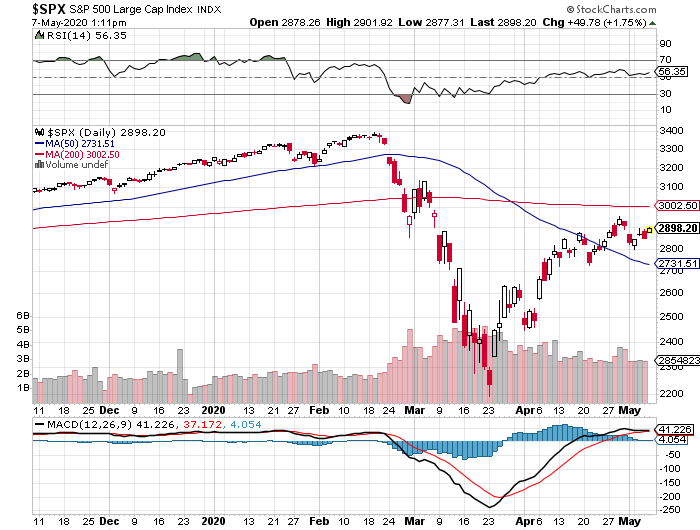
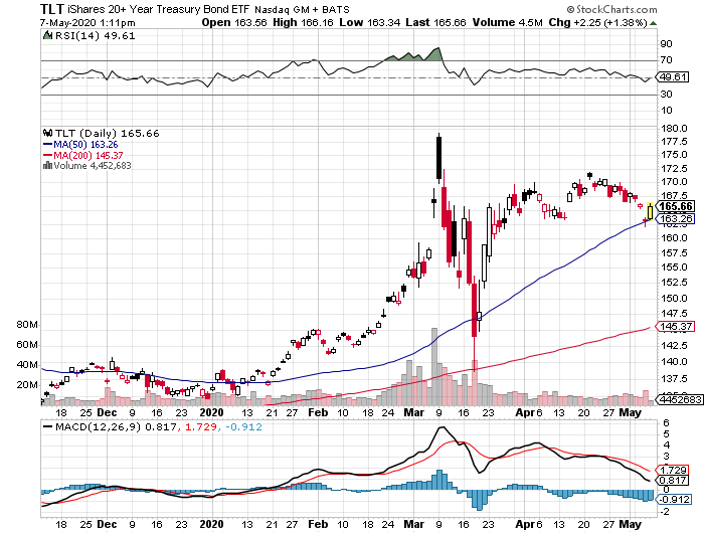
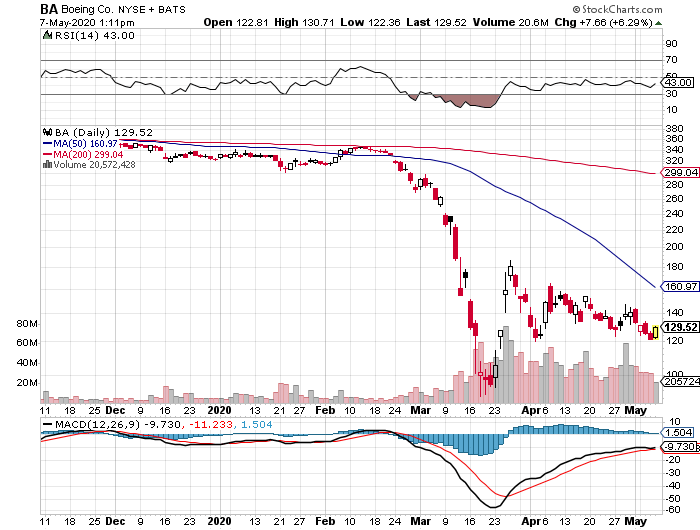
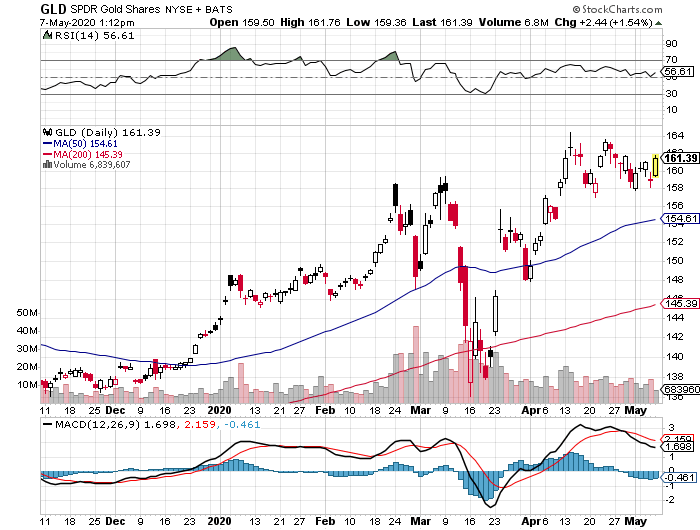
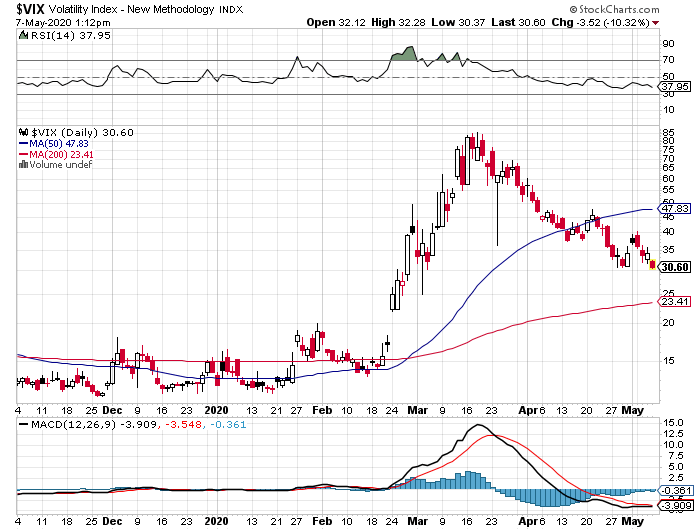

Global Market Comments
April 28, 2020
Fiat Lux
Featured Trade:
(EIGHT "REOPENING" STOCKS TO BUY AT THE MARKET BOTTOM)
(UAL), (DAL), (UNP), (CSX), (WYNN), (MGM), (BRK/A), (BA)
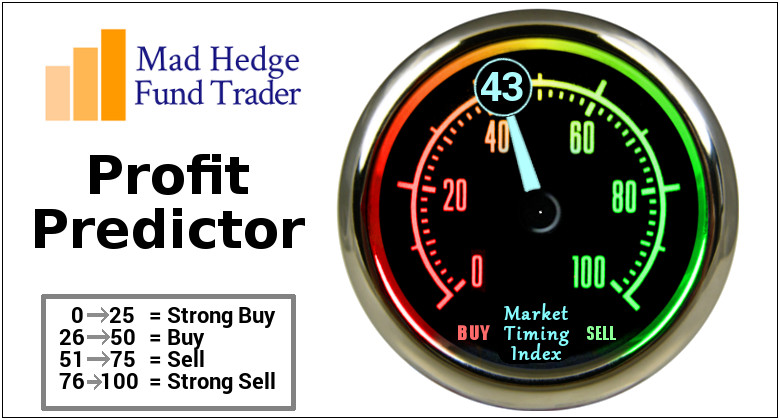
With the massive technology rally off the March 23 market bottom, the risk/reward for entering new trades has dramatically shifted.
Back then. I was begging followers to load the boat with the best big tech and biotech & healthcare names with call options and two-year LEAPS (Long Term Equity Participation Securities).
One reader told me he bought Humana (HUM) call options for 70 cents and sold them for a breathtaking $30 for a profit of 4,280%! FedEx showed up with a bottle of single malt Glenfiddich Scotch whiskey the next day.
The times have changed. Many tech stocks are now only a few dollars short of new all-time highs, like Microsoft (MSFT) and Apple (AAPL), or are at all tie highs, such as Amazon (AMZN), Teledoc (TDOC), and Zoom (ZM).
What a difference 6,000 Dow points make!
As a result, it is far more interesting now to pick up stocks that currently look like potential chapter 11 candidates, but will likely prosper once the American economy starts to reopen. Call it my “Reopening Portfolio.”
You can buy any of the stocks below outright, sit on them, and probably reap a double over the next two years. However, if you are a much more aggressive kind of trader like me, then you might consider LEAPS, where 500%-%1,000% profits are possible.
The advantage of a stock or a two-year LEAPS is that if we get a second Coronavirus wave in the fall, which is highly likely, you can outlast any short term pain and still come out a huge winner.
Some of these names we sold short at the market top and made a killing. It is now time to flip to the other side.
I am often asked how professional hedge fund traders invest their personal money. They all do the exact same thing. They wait for a market crash like we are seeing now and buy the longest-term LEAPS (Long Term Equity Participation Securities) possible for their favorite names.
The reasons are very simple. The risk on LEAPS is limited. You can’t lose any more than you put in. At the same time, they permit enormous amounts of leverage.
Two years out, the longest maturity available for most LEAPS, allow plenty of time for the world and the markets to get back on an even keel. Recessions, pandemics, hurricanes, oil shocks, interest rate spikes, and political instability all go away within two years and pave the way for dramatic stock market recoveries.
You just put them away and forget about them. Wake me up when it is 2022.
I put together this portfolio using the following parameters. I set the strike prices just short of the all-time highs set two weeks ago. I went for the maximum maturity. I used today’s prices. And of course, I picked the names that have the best long-term outlooks.
You should only buy LEAPS of the best quality companies with the rosiest growth prospects and rock-solid balance sheets to be certain they will still be around in two years. I’m talking about picking up Cadillacs, Rolls Royces, and even Ferraris at fire-sale prices. Don’t waste your money on speculative low-quality stocks that may never come back.
If you buy LEAPS at these prices and the stocks all go to new highs, then you should earn an average 131.8% profit from an average stock price increase of only 17.6%.
That is a staggering return 7.7 times greater than the underlying stock gain. And let’s face it. None of the companies below are going to zero, ever. Now you know why hedge fund traders only employ this strategy.
There is a smarter way to execute this portfolio. Put in throw away crash bids at levels so low they will only get executed on the next cataclysmic 1,000-point down day in the Dow Average.
You can play around with the strike prices all you want. Going farther out of the money increases your returns, but raises your risk as well. Going closer to the money reduces risk and returns, but the gains are still a multiple of the underlying stock.
Buying when everyone else is throwing up on their shoes is always the best policy. That way, your return will rise to ten times the move in the underlying stock.
If you are unable or unwilling to trade options, then you will do well buying the underlying shares outright.
Enjoy.
United Airlines (UAL) just raised $1 billion in a new equity issue to tide it over hard times. That is just a drop in the bucket for what it needs. It’s hard to imagine the company coming through the crisis without any government involvement. The most likely is for the feds to offer a big chunk of cash in exchange for a minority ownership. Around 35% might work, which is the portion the US Treasury of General Motors (GM) during the 2008-09 crash. Still, if you’re looking for a double in the shares, that just water off a duck’s back.
LEAPS: the January 21 2022 $45-$50 vertical bull call spread at a price of 83 cents delivers a 525% gain with the stock at $50, up 94.5% from the current level.
Delta Airlines (DAL) is Warren Buffet’s favorite airline, although he has been selling lately. All of the arguments above apply for this best run of US Airlines.
LEAPS: January 21 2022 $40-$45 vertical bull call spread at a price of 83 cents delivers a 502% gain with the stock at $45, up 98.8% from the current level.
MGM Resorts (MGM)
Yes, Las Vegas is reopening soon, but it certainly won’t resemble the old Vegas. (MGM) is the dominant hotel owner of the strip, owning the Bellagio, Mandalay Bay, Aria Resort, and MGM Grand hotels. It also has a China presence.
LEAPS: the January 21 2022 $25-$30 vertical bull call spread at 75 cents delivers 566% gain with the stock at $30, up 95.6% from the current level.
Wynn Hotels (WYNN)
We killed it on the short side with (WYNN), capturing an eye-popping 90% decline. (WYNN) is poised to lead the upturn. It has a major exposure in Macao, where China will lead any economic recovery.
LEAPS: the January 21 2022 $140-$150 vertical bull call spread at 90 cents delivers a 455% gain with the stock at $150, up 81% from the current level.
Union Pacific (UNP)
The reopening of industrial American means a resurgence of railroad traffic. These are not your father’s railroads. Over the last 30 years, they have evolved into highly efficient operators that offer the cheapest way far to over heavy good and bulk commodities, virtually turning into closet high-tech companies. (UNP) had the additional advantage in that as the country’s dominant East/West road, it stands to benefit the most from a recovery in trade with China. That is a likely outcome of any future administration.
LEAPS: the January 21 2022 $180-$185 vertical bull call spread at $1.40 delivers a 257% gain with the stock at $185, up 15.00% from the current level.
CSX Corp. (CSX)
Same arguments here, except that (CSX) wins on North/South trade, especially with Mexico. With a NAFTA 2 new trade agreement in place, this company benefits from an extra turbocharger.
LEAPS: the January 21 2022 $75.00-$77.50 bull call spread at 84 cents delivers a 495% gain with the stock at $77.50, up 16.27% from the current level.
Berkshire Hathaway (BRK/A)
Yes, they make more than sheets these days. Warren Buffet’s flagship holding company is the poster bot for industrial American. The shares are high priced, but after this 32% pullback, you may finally have a chance to get in.
LEAPS: the June 17 2022 $225-$230 vertical bull call spread at $2.61 delivers a 91.5% gain with the stock at $230, up 22.7% from the current level.
Boeing Co. (BA)
This has been the worst falling knife situation in the market for the last two years, cratering from $450 to $85, or down 81%. The decertification of the 737 MAX started the rot, and the grounding of its major airline customers was the coup de grace. This is another company that may require a government bailout and stock ownership, as it is a strategic national value. You may have to wait until the next administration as its Washington State location is currently politically incorrect.
LEAPS: the June 17 2022 $185-$190 bull call spread at $1.25 delivers a 400% gain with the stock at $190, up 47.8% from the current level.
Buy all eight of these and if they all work, your average return will be 411.4%.
Enjoy!
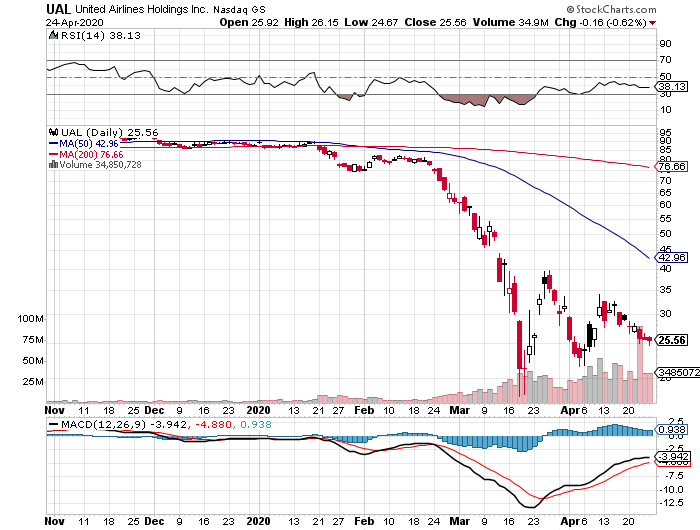
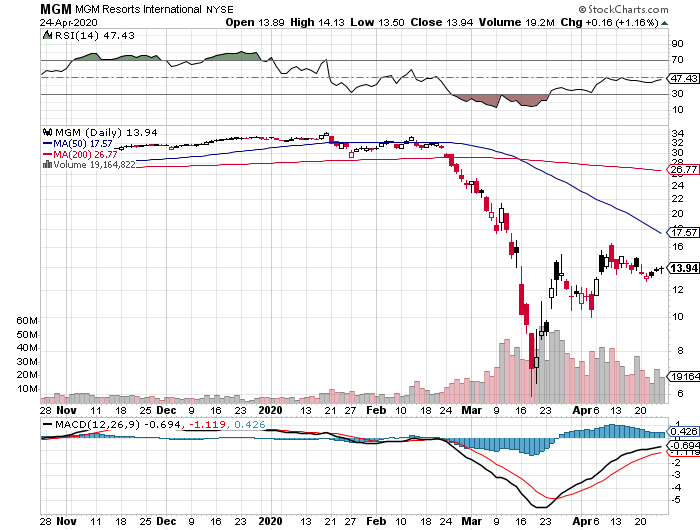
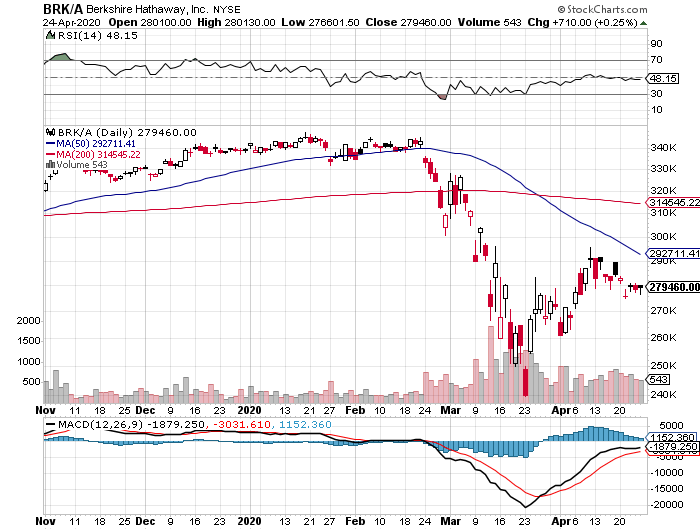
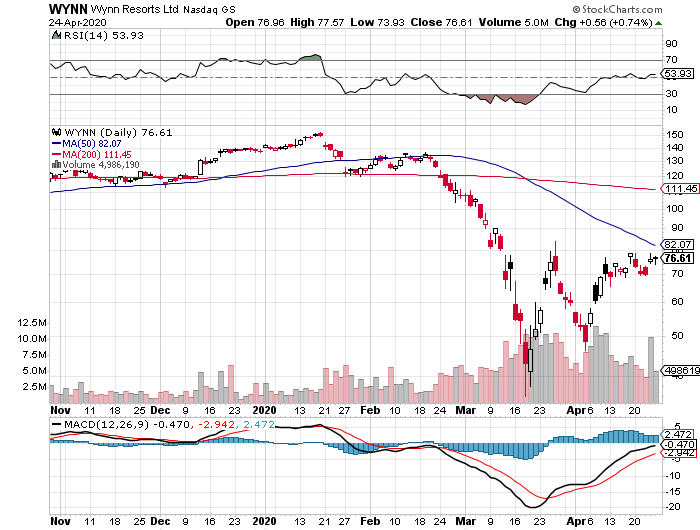

Global Market Comments
April 20, 2020
Fiat Lux
Featured Trade:
(MARKET OUTLOOK FOR THE WEEK AHEAD, or WHAT’S A FED PUT WORTH?),
(INDU), (SPX), (TLT), (ZM), (TDOC),
(NFLX), (UAL), (WYNN), (CCL)
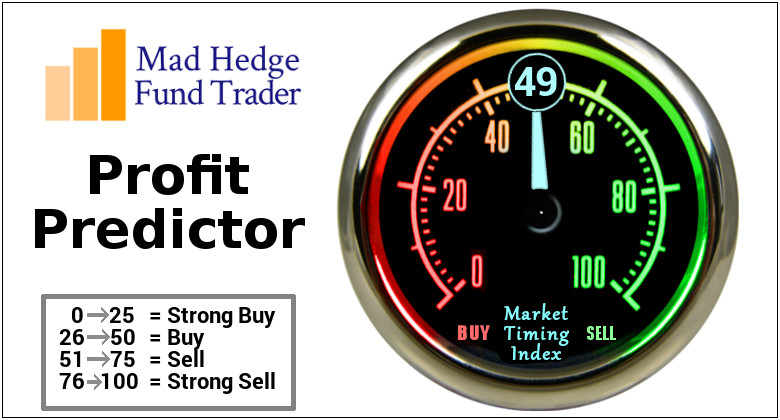
What is a Fed put worth?
That the question that traders and investors alike are pondering.
If the government had taken no action whatsoever in the face of the Corona pandemic the Dow average would easily be at 15,000 today, if not 12,000.
After all, the economic collapse we have seen has been even greater than the Great Depression. More than 22 million unemployed in four weeks? Back then, the Dow Average fell by 90%.
Enter the Feds.
Throw in $6 trillion in expected fiscal spending and $8-$0 trillion in Federal Reserve stabilization of the money markets and quantitative easing, and it makes a heck of a difference. As a result, the national debt will rocket from $23 trillion to at least $32 trillion by next year, a far faster increase than seen after Pearl Harbor.
Stocks love this.
In the past three weeks, the Dow Average has jumped an eye-popping 35% from 18,000 to over 24,000. We are likely trading at 25 X 2020 earnings, but that is just a guess at best. Nobody knows, with essentially all companies withdrawing guidance. On a valuation basis, stocks are now more expensive than at any time since 1929.
You can be excused for being confused, befuddled, and gob-sacked.
All of this adds up to a value of the Fed put of 9,000 in Dow Average terms, 17,000 in a worst-case scenario, and 27,000 if you want to go back to 1933 share valuations.
Stocks here are now priced for perfection. To buy shares here, you are making the following rosy assumptions:
1) The Corona epidemic is peaking and it is clear sailing from here.
2) Shelters-in-place ends in two weeks.
3) Critical shortages of medical supplies end.
4) US Deaths top out at 60,000 from the current 40,000, the most optimistic White House forecast.
4) Business will immediately bounce back to pre-epidemic levels
5) Domestic and international travel resume immediately
If all of the above take place, then at a stretch, shares are justified at maintaining current levels and will churn sideways from here.
Here is what is more likely:
1) We are nowhere close to a peak, especially in states that never sheltered-in-place, and there could be a secondary peak in the fall. At 2,000 a day, US deaths will easily top 100,000 in a month.
2) Shelters-in-place will extend to June in the most populous states.
3) Medical supply shortages will continue for the indefinite future, with 50 states bidding against each other to buy fake masks from China.
4) Dozens of large companies and perhaps a quarter of the country’s 30 million small businesses will go bankrupt before the recovery begins.
5) There is no sign that domestic and international travels are getting off the runway anytime soon.
If that is the case, then stocks here that are wildly overpriced are due for a retest of the Dow 18,000 and (SPX) 2,400 lows.
No matter what happens, traders should be cognizant of an enormous bifurcation of the market that has taken place.
Stay at Home stocks, like Zoom (ZM), Teladoc (TDOC), and Netflix (NFLX), have spectacularly outperformed the market. Many of these had already been recommended by the Mad Hedge Technology letter and the Mad Hedge Biotech & Healthcare letter because they were leaders in their own technologies (click here).
The problem with these companies is that they are all expensive, in some cases trading at hundreds of times their earnings.
Then there are the Reopening Stocks that will deliver outsized returns once we make it to the downslope of the epidemic. These include United Airlines (UAL), Wynn Hotels (WYNN), and Carnival Cruise Lines (CCL), which we heavily sold short near the market top, and led the recovery of the last three weeks.
The problem with these companies is that they may have to go bankrupt first, or at least accept a heavy government ownership and dilution of existing shareholders before they return to normal.
It’s a quandary that would vex Solomon.
I always tell people, if you want to make an easy, reliable, and safe living, get a job at the Post Office. Avoid the stock market.
OPEC cut oil production by 10 million barrels/day, for two months, and then 8 million barrels a day for the rest of the year. Oil prices plunged anyway to a 20-year low at $18.50 a barrel, as it only puts a small dent in the 34 million barrel a day oversupply. It only postpones the day when many energy companies go bankrupt.
The Economy could be turning on and off for 18 months, believes Fed governor Neil Kashkari. He may be partly right. I am expecting two Coronavirus waves to lead to two shutdowns in the spring and fall, and the stock market may reflect the same. If so, stocks are wildly overpriced here, and the bear market could last another year. Sell shorts, or at least add hedges, and buy the (SDS).
US Budget Deficit to top $3.8 trillion this year, the most since WWII. We were already headed for a monster $1.5 trillion in red ink before the virus hit. Now we are pouring gasoline on the fire. It'sis my worst-case scenario, I had the national debt rising from $23 trillion today to $30 trillion in a decade. It looks like that will happen by next year.
Only 90,000 cleared US airport security in one day, down from a typical 2.2 million, or down 95%. It appears that 90,000 people a day don’t care if they get Covid-19 or have already had it. Some 80% of all flights globally are grounded, with many countries now stranded. With massive debt loads, it is only a question of how soon the big US airlines go bankrupt and how much the government gets to own on the way back up. Don’t buy any airlines no matter how cheap they get.
US Retails Sales collapsed by 8.7% as the paycheck-free economics takes hold. The March Empire State Manufacturing Index crashed to a record low of 78% and March Industrial Production is off 5.4%, the lowest since 1946. The parade of the worst economic data in history has begun. And we go into this with stocks at record high valuations, more expensive than they were in January.
Goldman Sachs says this depression will be four times worse than the Great Recession of 2008-2009, likely falling 35% annualized in Q2. Unemployment will hit 15% or higher, but stocks will not retest the March lows. The bounce back in H2 will be bigger than any seen. It more or less corresponds to my view. They must have some smart people at (GS).
March Homebuilder Confidence brings the biggest crash in history, down 42 points to a reading of only 30. It's the greatest decline since the 35-year history of the index. The last time we were this low was in June 2012. Some 21% of builders are reporting virus disruption.
Housing Starts collapsed a stunning 22.3% in March, the worst one-month figure ever recorded. Social distancing makes open houses impossible. But this will be one sector that leads us out of the depression. There is still a chronic generational housing shortage.
Weekly Jobless Claims topped 5.1 million, taking the grim four-week tally to a staggering 21 million. Out of the frying pan, into the fire.
Gilead Sciences (GILD) drug sent stocks soaring, up 900 points overnight. Its Remdesivir brought rapid recovery in already infected patients at the University of Chicago in a phase three trial. The market is hypersensitive to any good Corona news. Sell into the rally.
China GDP took a 6.8% hit in Q1 as the Corona pandemic takes its toll. Services are recovering faster than manufacturing, which is why the smog has not come back yet. And international trade has ground down to zero. Public transit has been abandoned for private cars. It could be a preview to our own recovery.
When we come out on the other side of this, we will be perfectly poised to launch into my new American Golden Age, or the next Roaring Twenties. With interest rates at zero, oil at $18 a barrel, and many stocks down by three quarters, there will be no reason not to. The Dow Average will rise by 400% or more in the coming decade.
My Global Trading Dispatch performance recovered nicely this week, thanks to some frenetic trading. I used the Monday 700-point dive in the market to cover most of my bearish positions and add short-dated longs in Apple (AAPL) and Facebook (FB).
Finally, I dove back into selling short the US bond market on the assumption that unprecedented borrowing will destroy prices.
My short volatility positions (VXX) were hammered again, even though volatility declined on the week. There seems to be heavy short selling of deep out-of-the-money puts on the assumption that the Volatility Index (VIX) won’t rise above $50 again.
We are now up +0.45% in April, taking my 2020 YTD return down to -7.97%. That compares to a loss for the Dow Average of -15% from the February top. My trailing one-year return returned to 33.88%. My ten-year average annualized profit returned to +33.67%.
This week, Q1 earnings reports continue, and so far, they are coming in much worse than the most dire forecasts. The only numbers that count for the market are the number of US Coronavirus cases and deaths, which you can find here.
On Monday, April 20 at 7:30 AM, the Chicago Fed National Activity Index comes out.
On Tuesday, April 21 at 9:00 AM, the March Existing Homes Sales are released.
On Wednesday, April 22, at 9:30 AM, the Cushing Crude Oil Stocks are announced.
On Thursday, April 23 at 8:30 AM, Weekly Jobless Claims will announce another blockbuster number.
On Friday, April 24 at 7:30 AM, US Durable Goods for March are printed. The Baker Hughes Rig Count follows at 2:00 PM. Expect these figures to crash as well.
As for me, I am sitting here eating a pineapple upside-down cake that my daughter just whipped up. It's my favorite cake made by my mother, which I always got on my birthday.
Of course, I have to wash the dishes. If anyone wants to supplement their trading income, housekeeper and domestic and wants to live in mansions at Lake Tahoe and San Francisco, please contact customer support immediately.
Stay healthy.
John Thomas
CEO & Publisher
The Diary of a Mad Hedge Fund Trader

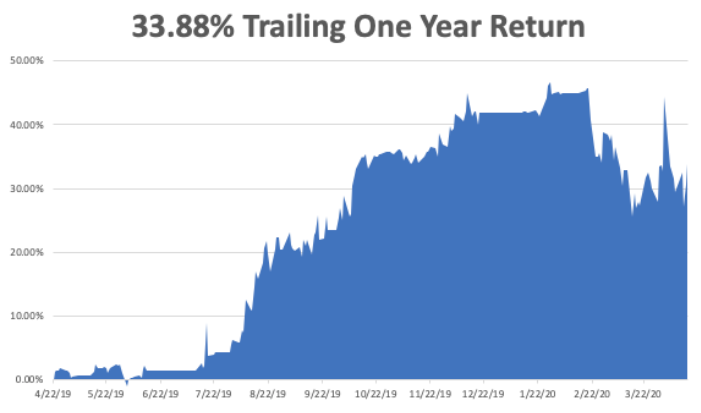
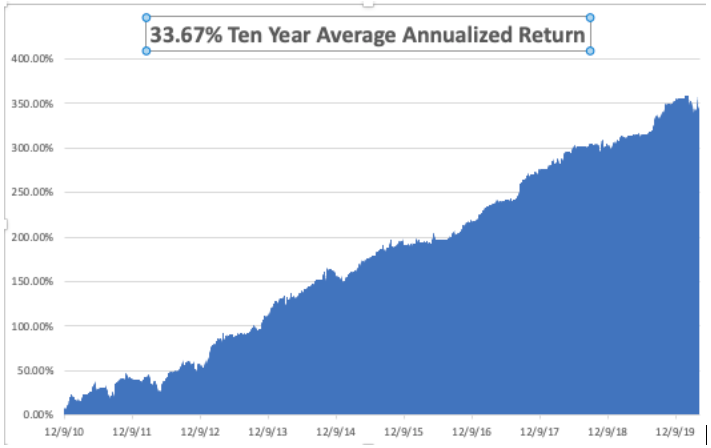
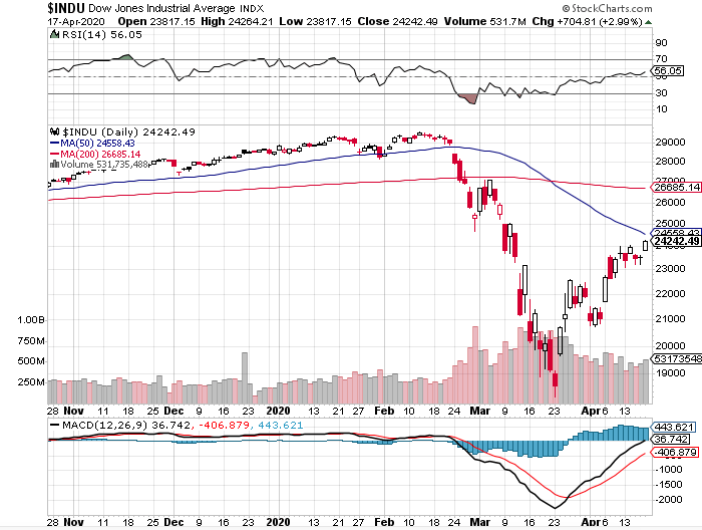
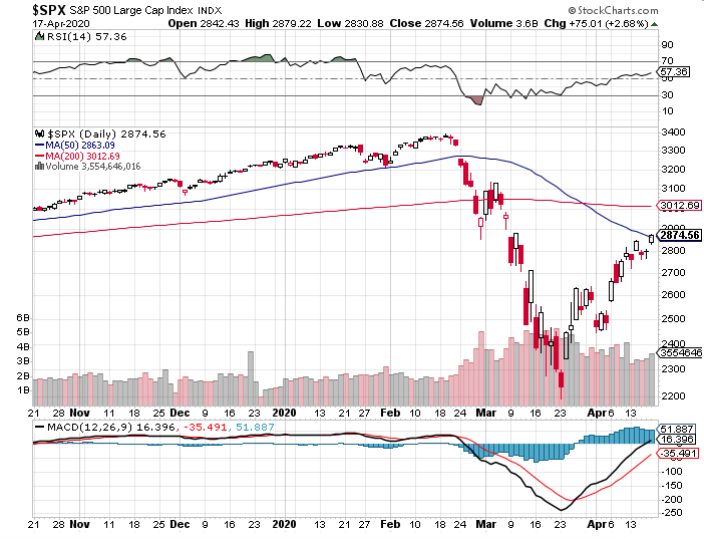
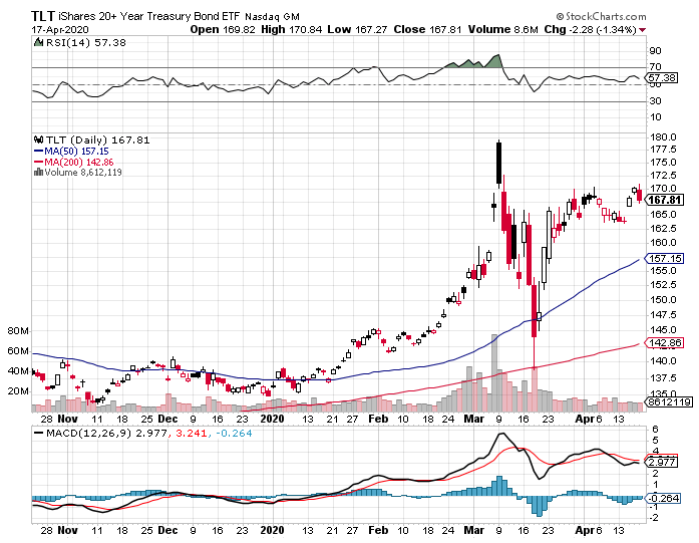
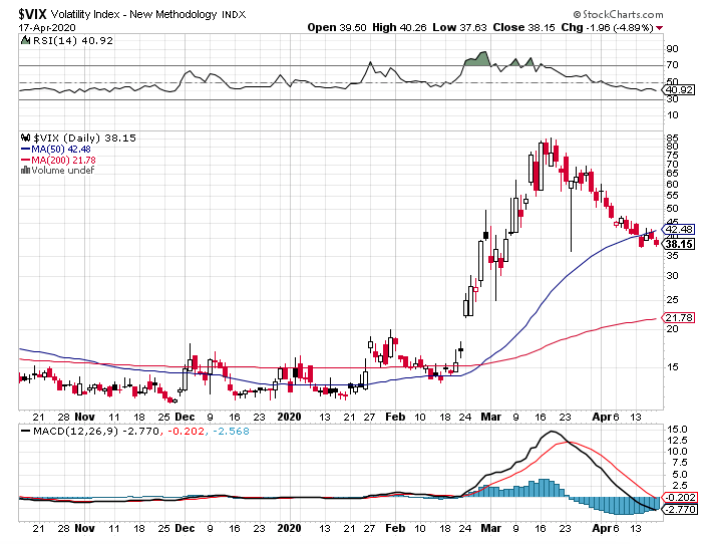
Legal Disclaimer
There is a very high degree of risk involved in trading. Past results are not indicative of future returns. MadHedgeFundTrader.com and all individuals affiliated with this site assume no responsibilities for your trading and investment results. The indicators, strategies, columns, articles and all other features are for educational purposes only and should not be construed as investment advice. Information for futures trading observations are obtained from sources believed to be reliable, but we do not warrant its completeness or accuracy, or warrant any results from the use of the information. Your use of the trading observations is entirely at your own risk and it is your sole responsibility to evaluate the accuracy, completeness and usefulness of the information. You must assess the risk of any trade with your broker and make your own independent decisions regarding any securities mentioned herein. Affiliates of MadHedgeFundTrader.com may have a position or effect transactions in the securities described herein (or options thereon) and/or otherwise employ trading strategies that may be consistent or inconsistent with the provided strategies.
This site uses cookies. By continuing to browse the site, you are agreeing to our use of cookies.
OKLearn moreWe may request cookies to be set on your device. We use cookies to let us know when you visit our websites, how you interact with us, to enrich your user experience, and to customize your relationship with our website.
Click on the different category headings to find out more. You can also change some of your preferences. Note that blocking some types of cookies may impact your experience on our websites and the services we are able to offer.
These cookies are strictly necessary to provide you with services available through our website and to use some of its features.
Because these cookies are strictly necessary to deliver the website, refuseing them will have impact how our site functions. You always can block or delete cookies by changing your browser settings and force blocking all cookies on this website. But this will always prompt you to accept/refuse cookies when revisiting our site.
We fully respect if you want to refuse cookies but to avoid asking you again and again kindly allow us to store a cookie for that. You are free to opt out any time or opt in for other cookies to get a better experience. If you refuse cookies we will remove all set cookies in our domain.
We provide you with a list of stored cookies on your computer in our domain so you can check what we stored. Due to security reasons we are not able to show or modify cookies from other domains. You can check these in your browser security settings.
These cookies collect information that is used either in aggregate form to help us understand how our website is being used or how effective our marketing campaigns are, or to help us customize our website and application for you in order to enhance your experience.
If you do not want that we track your visist to our site you can disable tracking in your browser here:
We also use different external services like Google Webfonts, Google Maps, and external Video providers. Since these providers may collect personal data like your IP address we allow you to block them here. Please be aware that this might heavily reduce the functionality and appearance of our site. Changes will take effect once you reload the page.
Google Webfont Settings:
Google Map Settings:
Vimeo and Youtube video embeds:
